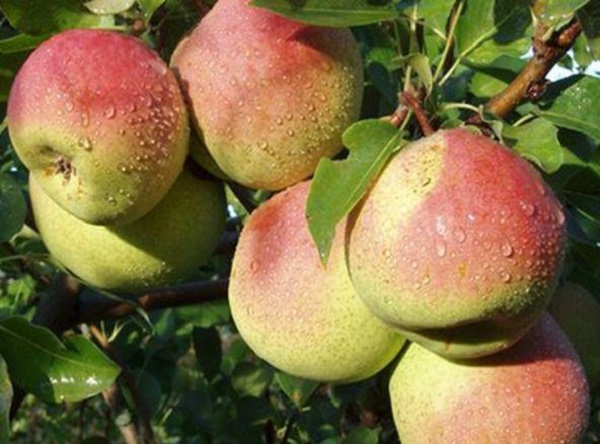Today, breeders have bred more than 300 different varieties of pears. All of them are distinguished by the taste of the fruit, the size of the tree and the characteristics of growing and care.
In this article we will talk about an interesting and tasty variety of Krasuli pear, let's talk about its description and main characteristics.
Table of contents
Description of the variety Krasulya
The cultivar of Krasulia pear is a summer variety, it was bred by crossing the types Black and Little Joy.EA Flanckberg worked at the South Ural Scientific Research Institute for Horticulture and Potato. Today, the Krasulia pear variety is grown both on an industrial scale and in summer cottages.
The height of the tree on average reaches more than 4-5 m. Sprawling branches, tend upwards, which allows the sun to penetrate to the bottom of the tree. Brown crown, one of the characteristics of the variety is that there are small spines on the trunk of the tree, which make harvesting difficult.
Barrel cone-shaped. The leaf plate is wide, dense, rounded shape with pointed ends. Young leaves have light green hues, during the summer they change color to dark green hues, with yellowish streaks. The grade blossoms in the middle of May, large, white inflorescences, with tart aroma.
Pear fruits are small both in size and weight, the average pear weight does not exceed 90 g. The fruits of this variety have a beautiful color, at the time of ripening, the pear takes on green and light green shades. During the summer, the fruits change their tones to yellow-green. And that side of the pear, on which direct sunlight fell, becomes red-orange by the end of the summer.The shape of the fruit is oval, similar to pomegranate.
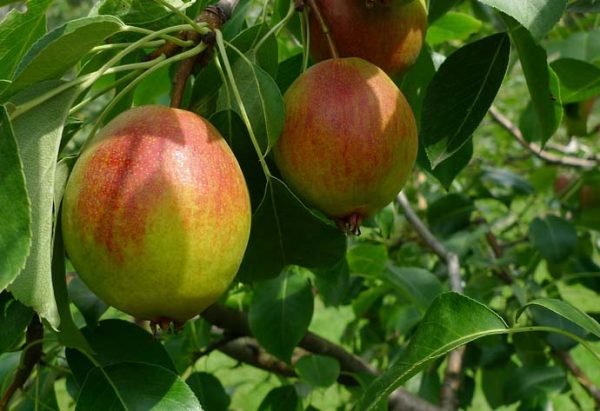
The variety Krasul was loved by many because of its taste, the pear has a thin peel, fleshy, juicy pulp. In addition, the variety is sweet, has a pleasant aroma. Fruits ripen in mid-August, remain on the tree for no more than 2 weeks, after which they become soft and fall off. Peeled fruits are also stored for a short time, about 2 weeks in the open, and not longer than 3 weeks in the refrigerator. Besides The Krasulia pear variety is not intended for winter storage.
The yield of a variety is high, fruiting begins already in the 5th year, on average, more than 40 kg of crop per summer can be harvested from an adult tree with proper care. Often, so that the branches do not break off under the weight of the fruit, “Krasuli” requires special supports that will support its branches.
It is interesting to form the ovary on a pear; Krasulia refers to a mixed type of fruiting; therefore, ovaries on it are formed not on short fruit twigs, but on last year's gains, the more interesting and unusual this sort of pear is.
One more The peculiarity of this variety is its resistance to frost. Krasulya easily tolerates cold and severe winters, cold and bad weather.
Advantages and disadvantages
The advantages of this type are:
- winter hardiness of the variety (Krasulia perfectly tolerates winters);
- resistance to diseases and pests;
- the compactness of the tree, despite its sprawling branches, Krasulia does not take up much space in the garden plot;
- high yields (adult tree fruits every year);
- fruits ripen quickly during the summer.
Of course, there are some disadvantages of the variety:
- The small size of the fruit (by weight 1 pear does not exceed one hundred grams);
- In a cool summer, pear changes its taste, becomes tart and not sweet;
- Fruits are not stored for a long time (1 week without a fridge and 2 weeks in the cold), nor can they be stored until winter.
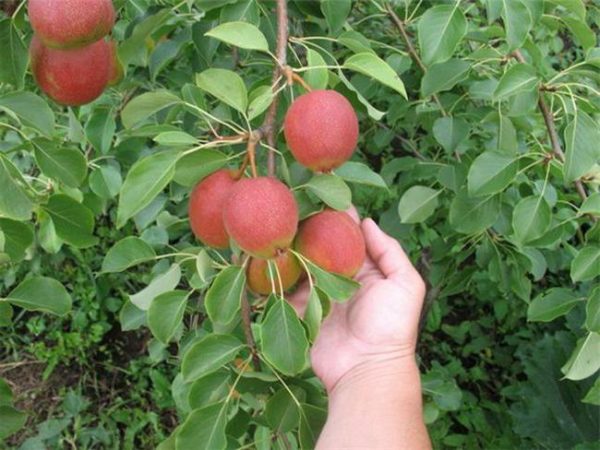
Selection of seedlings
High yield varieties depends on the quality of seedlings. When choosing young stock, first of all it is worth paying attention to the roots of the tree. They should not be rotten parts, roots with signs of the disease. It is necessary that the root of the tree was dry, brownish in color.
When choosing a pear seedling it is necessary to inspect the branches, they should not be broken or damaged. You can buy a tree both in early spring and in autumn.
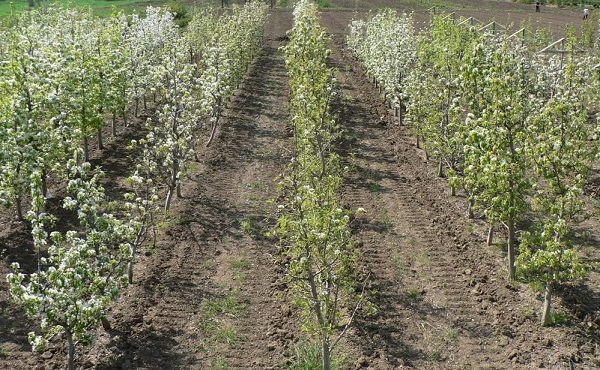
Choosing a landing site
For the growth of seedlings is also important to choose the site for planting. The variety Krasulia prefers to grow in the sun, where during the day a lot of sunlight. But because of its spreading branches, the pear does not “love” the close proximity to other trees, it prefers to grow separately, aside. This variety is not recommended to plant under large trees, they will not give enough sunlight to grow pears.
The soil
As for the soil, the variety Krasul is not naughty and easily takes root on any soils, clayey, sandy. However, it is not necessary to plant seedlings in the marshy areas, where groundwater is located close.
Due to the excess moisture in the soil, pear roots can rot, the plant itself loses its growth rate, and the fruits become soft and quickly fall off. The soil for planting will fit any, black soil, sandy or slightly clay.
Time to land
Pear Krasulia can be planted in the spring and autumn. It is better to plant a tree in the spring in the middle of April or in the beginning of May, when frosts will pass and the soil will be warmed by the sun.
If planting falls on autumn time, then it is important to have time to plant a seedling before the onset of the first frost, and preferably a month before the onset of cold weather. The right time to land from late September to early November. Until the cold, the tree will have the opportunity to take root in a new place and survive the first winter.
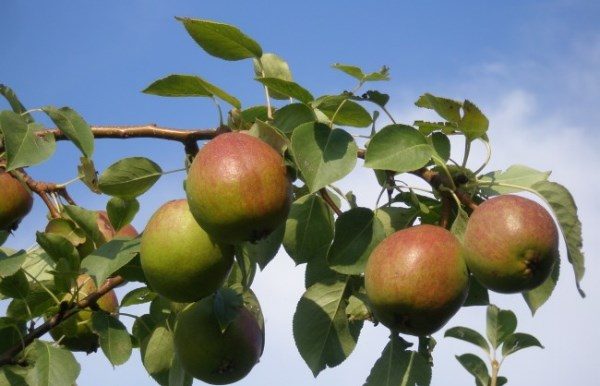
Landing technology
Planting a Krasulia pear is not difficult, the variety quickly takes root in a new place, it does not need special care.
- Planting pears should begin with cooking pit. Its size depends on the seedling's root system; the larger it is, the wider and deeper the pit will be needed. Before planting, you also need to inspect the roots of the tree, if they are tangled, they can be safely shortened or cut, but not too much.
Before planting, it is recommended to lower the pear roots in a bucket with a solution of potassium permanganate. This will not only neutralize the roots, but also save the tree from many diseases.
- Further it is good to lay sawdust on the bottom of the pit, small pebbles, humus. The earth should also be loose, moist, without lumps and roots of other plants.
- After the drainage is laid, the pit must be pour a bucket of water and wait until the earth absorbs moisture and settles.
- Then nand the bottom gently fit the roots, the tree should be strictly vertical. The roots are covered with earth, after which the pear must be poured with 2-3 buckets of water.
- After planting, the ground around the tree should be well cultivated.so it will keep moisture longer. The next watering the tree will need in a day, 1-2 buckets of water will be enough.
In general, Krasulia pear quickly takes root in a new place, especially if the seedling is healthy. When properly planted pear takes root in a couple of weeks, and even earlier. And the first leaflets in a month is a sure sign that the sapling is rooted and began to grow. Now only the right care will help to collect the kilos of the crop.
Care for Krasuli pear
Watering
Krasulia pear loves moisture, but, like most plants, her, it is important not to pour. 2-3 buckets of water once a week will be enough for her. Its branched root system is capable of “extracting” moisture for itself. Increase the need for watering in 2 cases:
- -in too dry and hot weather;
- during fruit ripening.
Young saplings need a lot of moisture, but measure is also needed here.
Too moist soil threatens the development of many diseases of the root system, the roots of the tree can rot.
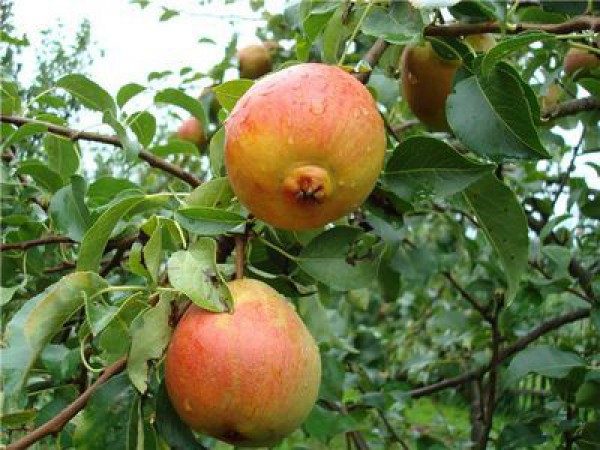
Top dressing
In general, adult the tree is able to provide itself with the necessary substances and vitamins. But he also needs vitamins for growth, but they need to be made very carefully, based on the characteristics of the tree itself. If it became early to bear fruit, then, of course, it needs fertilizers. But, if it forms only undergrowth, then you should not spend on top dressing on it.
Annually, it is better to apply fertilizer under a pear in early spring, it can be organic fertilizer, a mixture of ammonium nitrate and urea, superphosphate, potassium sulphate, or common ash. Used to feed nitrogen fertilizers, they stimulate the growth of young shoots.
Crown trimming and leveling
Often you will notice that the tree begins to fall on its side. To level it is necessary, remove the top layer of soil without damaging the roots. Then a stake is driven in from the opposite side of the slope and a tree trunk is attached to it. The leveling of the tree is not much different from planting, so it needs good care after leveling.
The variety needs annual pruning. It is necessary for the young growth not to clog the fruit-bearing branches. In the spring it is better to cut the pear before the leafing. Broken branches, damaged by diseases and young shoots are cut.
Diseases and pests
The variety withstands various diseases quite stably, pests are not terrible for it, but often subject to other misfortunes, for example, powdery mildew. This disease damages the leaves of the tree, the leaf plates turn brown, curl, fall, and the tree itself slows down its growth.
Usually, young leaves and shoots are affected. But inflorescences are also damaged, they are covered with white bloom, they dry out and do not give ovaries.
The disease can destroy more than 70% of the crop and cause significant damage to the tree. To combat this disease, it is good to use a solution of colloidal sulfur (2-3 treatments with an interval of 2 weeks). Also in the autumn it is necessary to prune all the infected branches.
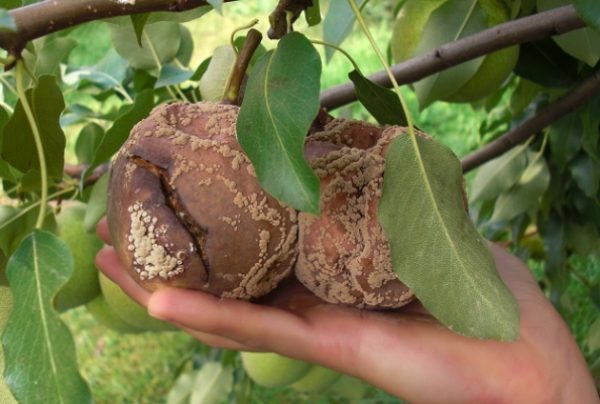
Fruit rot most often occurs in Krasuli during the rainy season. It affects the disease not only the leaves, but also the fruits. At first small brownish spots appear on them, the core becomes soft, brown in color and such fruits are unsuitable for consumption. Sick pears must be removed from the branches and from the site, and for prophylaxis it is necessary to spray the tree with either a solution of urea or bordic liquid.
Rust - The cause of the development of this disease is a pathogenic microscopic fungus. It covers the leaves of the pear, they turn dark brown and fall. This disease extends not only to the leaves, but also to the bark of the tree.
For prevention, it is necessary to spray the tree with a solution of ash and soap, in the spring, before flowering.In autumn it is necessary to spray the tree with sulfur or burgundy liquid.
Cytosporosis or stem rot infects the bark of a tree regardless of its age. Contributes to the development of this disease sunburn, drought or severe frosts. The disease manifests itself on a tree trunk, the bark of which acquires a dark brown color, gradually dries out and dies.
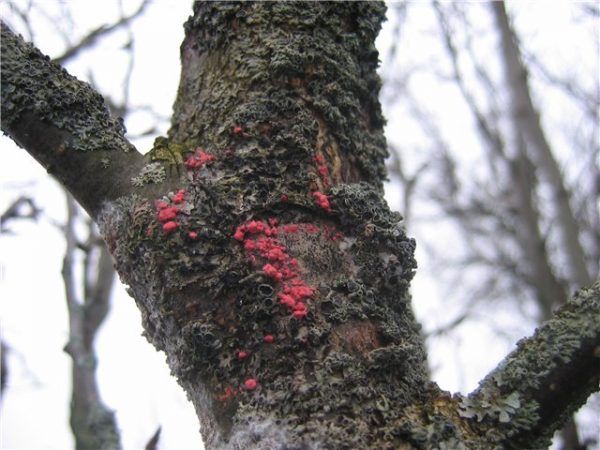
If the disease has just begun to spread, then with a sharp knife you need to cut off the affected areas, process them with copper sulfate. But in order to prevent disease, it is better to treat the tree trunk with whitewash in spring.
But not only diseases slow down the growth of the tree, but also pests, such as green aphids. This insect sucks the entire juice from the leaves and young shoots. In addition, green aphid secretes mucus, which contributes to the development of soot mushroom. To combat aphids, it is necessary to spray the tree repeatedly. The first time before the leaves bloom in spring, the second time before flowering and the third time before the formation of fruits. Purchase chemicals like Kinmiks or Iskra will do.
Pear moth - but rather a butterfly that lays eggs on sheets. During the summer of them appear caterpillars, devouring the fruit. Especially this pest likes to dwell on young pear trees. You can fight the butterfly with the help of the drug "Kinmiks" or "Agravertin".
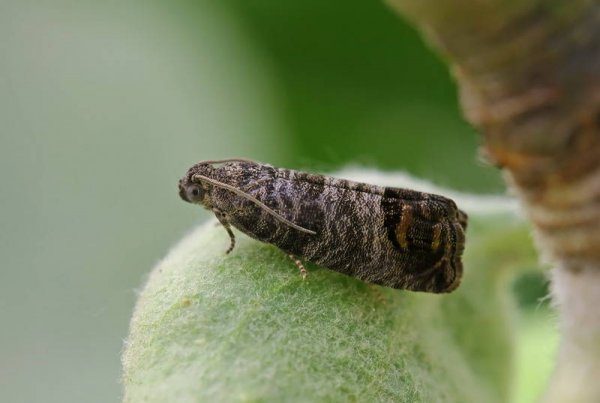
Pear Mite - another pear pest living in the bark of a tree and in the scales of the buds. This parasite is activated in the spring, sucks the juices from the young leaves, after which they are deformed. The tree stops growing, the branches acquire bizarre forms, the fruits are not proud to be consumed. You can fight with a pear mite with the help of chemical agents, or apply a solution of colloidal sulfur.
Variety Grushi Krasulia fell in love with many gardeners because of its high yield, because more than a dozen fruits can be removed from a single tree during a season. In addition, the pears of this variety have excellent taste characteristics, sweet fruits, with a pleasant aroma.Unpretentious tree and care, does not require much attention, but simply pleases gardeners with its beautiful and tasty fruits.
